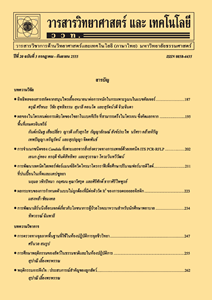ผลของความเข้มข้นของฟอสโฟลิพิดต่อสมบัติเคมีกายภาพและความคงตัวของน้ำมันปลาในไลโพโซม
Main Article Content
Abstract
The purpose of this study was aimed to investigate the effect of phospholipid concentrations on physicochemical properties of salmon fish oil, extracted from salmon belly (Oncorhynchus mykiss), encapsulated in liposome. Liposomes were prepared from three different concentrations of phospholipids (PC=70 %) at 2, 3 and 4 %w/v together with sonication was employed on particle size reduction. Encapsulated fish oil in liposome was determined for the physical characteristics including particle size, microstructure using laser confocal microscope, color and fatty acid profile. Oxidation was monitored during 4 weeks storage at 4 ºC by measuring the peroxide value (PV) and thiobarbituric acid reactive substances (TBAR). The results showed that all liposomes prepared from different concentrations of phospholipid were not significantly different (P > 0.05) in size, microstructure, color as well as PV and TBAR. For fatty acid profile, it was found that types of fatty acid in fish oil were not significantly different after encapsulation. The sum of fatty acids showed monounsaturated fatty acids > polyunsaturated fatty acids > saturated fatty acids. The ratios of ω-6 : ω-3 were 1.13-1.90 : 1 which was acceptable based on recommended intake. Thus, the optimal concentration of phospholipid at 2 %w/v was sufficient to maintain the physicochemical properties of salmon fish oil. This study suggest a possible use of salmon fish oil in the liposome form for food industry.
Keywords: liposome; fish oil; salmon; phospholipid; oxidation
Article Details
References
[2] Klaypradit, W., Worawattanamateekul, W., Taksima, T. and Intharapongnuwat, W., 2014, Characterization of refined oils from atlantic salmon belly as affected by degumming, Kasetsart Univ. Fish. Res. Bull. TH 38: 1-14.
[3] Akoh, C.C. and Min, D.B., 2008, Food Lipids: Chemistry, Nutrition, and Biotechnology, 3rd Ed., Taylor & Francis, 1028 p.
[4] García-Moreno, P.J., Guadix, A., Guadix, E.M. and Jacobsen, C., 2016, Physical and oxidative stability of fish oil-in-water emulsions stabilized with fish protein hydrolysates, Food Chem. 203: 124-135.
[5] Kumar, L.R.G., Chatterjee, N.S., Tejpal, C.S., Vishnu, K.V., Anas, K.K., Asha, K.K., Anandan, R. and Mathew, S., 2017, Evaluation of chitosan as a wall material for microencapsulation of squalene by spray drying: Characterization and oxidative stability studies, Int. J. Biol. Macromol. 104: 1986-1995.
[6] Wu, Q., Zhang, T., Xue, Y., Xue, C. and Wang, Y., 2017, Preparation of alginate core–shell beads with different m/g ratios to improve the stability of fish oil, LWT-Food Sci. Tech. 80: 304-310.
[7] New, R.R.C., 1990, Liposomes: A practical approach, IRL Press, UK, 301 p.
[8] American Oil Chemists’ Society, 2003, AOCS official method cd 8b-90, Reapproved 2003, Peroxide value, acetic acid, isooctane method, AOCS, Champaign, III., USA.
[9] Karnjanapratum, S. and Benjakul, S., 2015, Antioxidative gelatin hydrolysate from unicorn leatherjacket skin as affected by prior autolysis, Int. Aquat. Res. 7: 101-114.
[10] Association of Official Analytical Chemists, 2000, AOAC official method 991.39, Fatty acids in encapsulated fish oils and fish, AOAC, Gaithersburg, Maryland, USA.
[11] Intharapongnuwat, W., 2014, Characteriza-tion of Refined Oil from Atlantic Salmon Belly as Affected by Degumming and Enrichment of Refined Salmon Oil with Capric Acid by Enzymatic Acidolysis, Ph.D. Thesis, Kasetsart University, Bangkok, 171 p.
[12] Chan, Y.H., Chen, B.H., Chiu, C.P. and Lu, Y.F., 2004, The influence of phytosterols on the encapsulation efficiency of cholesterol liposomes, Int. J. Food Sci. Tech. 39: 985-995.
[13] Soema, P.C., Willems, G.J., Jiskoot, W., Amorij, J.P. and Kersten, G.F., 2015, Predicting the influence of liposomal lipid composition on liposome size, zeta potential and liposome-induced dendritic cell maturation using a design of experiments approach, Eur. J. Pharm. Biopharmaceut. 94: 427-435.
[14] Li, J., Wang, X., Zhang, T., Wang, C., Huang, Z., Luo, X. and Deng, Y., 2015, A review on phospholipids and their main applications in drug delivery systems, Asian J. Pharm. Sci. 10: 81-98.
[15] O’Dwyer, S.P., O’Beirne, D., Ní Eidhin, D., Hannon, J.A. and O’Kennedy, B.T., 2013, Oxidative stability of tuna fat spreads (o/w/o emulsions) using conventional lipid oxidation methods, spme-gc/ms and sensory analysis, Eur. Food Res. Technol. 237: 385-398.
[16] Weiss, J. and McClements, D.J., 2001, Color changes in hydrocarbon oil-in-water emulsions caused by ostwald ripening, J. Agric. Food Chem. 49: 4372-4377.
[17] Toniazzo, T., Berbel, I.F., Cho, S., Fávaro-Trindade, C.S., Moraes, I.C.F. and Pinho, S.C., 2014, ß-carotene-loaded liposome dispersions stabilized with xanthan and guar gums: Physico-chemical stability and feasibility of application in yogurt, LWT-Food Sci. Tech. 59: 1265-1273.
[18] Annamalai, J., Dushyant, C.K. and Gudipati, V., 2015, Oxidative stability of microencapsulated fish oil during refrigerated storage, J. Food Proc. Preserv. 39: 1944-1955.
[19] Sebaaly, C., Jraij, A., Fessi, H., Charcosset, C. and Greige-Gerges, H., 2015, Preparation and characterization of clove essential oil-loaded liposomes, Food Chem. 178: 52-62.
[20] Cui, L. and Decker, E.A., 2016, Phospho-lipids in foods: Prooxidants or antioxidants?, J. Sci. Food Agric. 96: 18-31.
[21] Simopoulos, A.P., 2002, The importance of the ratio of omega-6/omega-3 essential fatty acids, Biomed Pharmacother 56: 365-379.
[22] Mutalik, S., Salian, S.R., Avadhani, K., Menon, J., Joshi, H., Hegde, A.R., Kumar, P., Kalthur, G. and Adiga, S.K., 2014, Liposome encapsulated soy lecithin and cholesterol can efficiently replace chicken egg yolk in human semen cryopreservation medium, Syst. Biol. Reprod. Med. 60: 183-188.
[23] Rumin, J., Bonnefond, H., Saint-Jean, B., Rouxel, C., Sciandra, A., Bernard, O., Cadoret, J.P. and Bougaran, G., 2015, The use of fluorescent nile red and bodipy for lipid measurement in microalgae, Biotechnol. Biofuels 8: 42.
[24] Liu, Z.H., Yip, P.K., Adams, L., Davies, M., Lee, J.W., Michael, G.J., Priestley, J.V. and Michael-Titus, A.T., 2015, A single bolus of docosahexaenoic acid promotes neuroplastic changes in the innervation of spinal cord interneurons and motor neurons and improves functional recovery after spinal cord injury, J. Neurosci. 35: 12733-12752.


